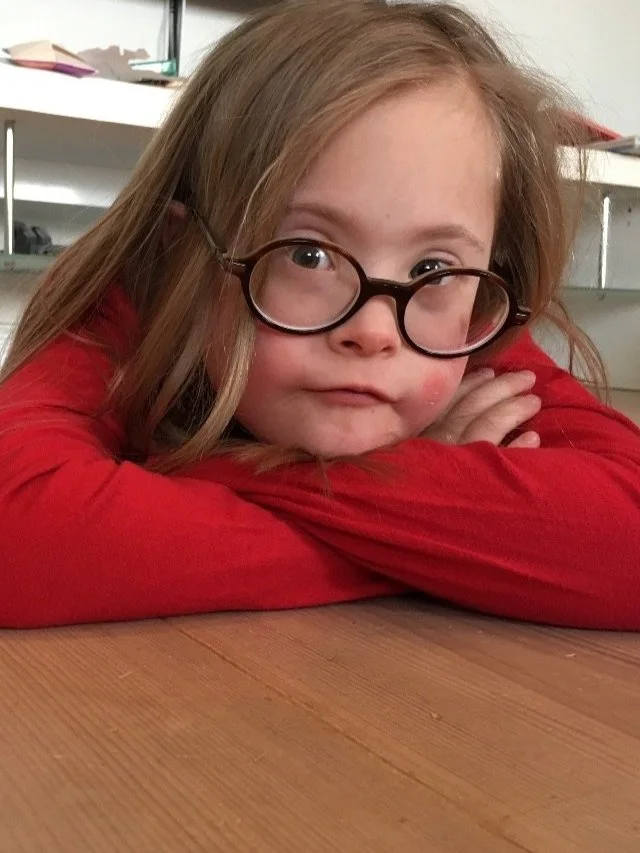The Karlstad model and the importance of networks. Part two
Enjoy!i
When we had our daughter Doris, born with Down Syndrome, a number of different language development methods (models) were presented to us parents. Different special educational ways to work with Doris. When you then stand at the local children Habilitation center as a newly hatched parent of a child, who you know will have slightly greater challenges than many other children in this life, most things feel unmanageable. If you then get, as in this case, many small fragments and snippet of information from a special educator and speech therapist about how to work, well, then in the end you know neither out nor in. To the direct question, they answered: "Well, you can pick a little here and there".
If you, like my husband and I, are completely inexperienced and ignorant in the field, this will stifle rather than help. It creates frustration, stress and it feels like swimming in a pool of helplessness. You want to shout out: “Give us something concrete! Give us tools! Give us a plan! ” To try a little here and try a little there, is no plan. The stress that arises when you understand that the child has special needs is hardly lessened by the fact that you as a parent should try to get acquainted with a lot of different special educational variants.
This is how it started when we as parents and total novices in the field decided to do something concrete, get tools and come up with a plan for how we would work with our daughter's learning and language development. We contacted a specialist and supervisor in the Karlstad model and we have never regretted this. This is where our work began and we focused on all of us who were in Doris' immediate vicinity (her own family, her teachers and assistants, grandparents) working together for the next period.
From the beginning, we worked with simple sounds that became images, shapes and eventually grammar. We worked with letters and endings, with fairy tales, stories and everyday life. We created an environment where Doris became a very active conversation partner and all this with the help of the Karlstad model's methodology and our supervisor. We created a network in the form of a study circle, where everyone in the local community was included (including relevant teachers and staff from the school).
In the beginning, it was no major problem to get the preschool to keep up. It almost became a bragging project. The educators drew, the student health special educator was part of our network, the "resource person" from the preschool was of course also included. It worked with great enthusiasm and Doris made progress. Fantastic progress. And the reason for this was of course that we all gathered around and worked with Doris in the same way.
When it was time to start school, the little surprise came. The headmaster worked hard to make us choose an integrated special school so that the little adorable girl still remained in the class but that they did not have to pay. But no, the network said that special school was not relevant at all. Doris got to start, despite some protests, in regular elementary school and under regular elementary school plan and we got the class teacher interested and hooked. Today, Doris will soon be out of second grade. She reads, writes, adds, subtracts, multiplies, reports, etc. just like the other children and for the most part also with them. If she will reach primary school goals? Yes, it is not at all certain, but she has been through the same thing as her classmates and is not least with social skills that she probably would not have acquired otherwise.
Doris was three years old when we started. We then got help from our supervisor in the Karlstad model to see exactly where Doris was. We did a test to see where Doris was linguistically. Every now and then it was about being able to say / draw different words and then it also wondered about the understanding. Our supervisor also mapped out what happened in kindergarten and in Doris' everyday life as well as family life. Based on this, she then made an action plan that focused on a specific area. The action plan contained, among other things, a dictionary. Words that were important were saved as a dictionary where the words were partly written but also with image support and characters.
Concepts like Phonology. What sounds were difficult for Doris? The letters p, t and k-sounds e.g. Grammar. How to build and work with, for example, three-word sentences. Pragmatics, ie how I use my language, such as asking questions and answering. As well as prosody and this was then song and rhymes, because we are a family who are happy to read and sing which took up a large part of the work.
In this action plan, the entire network was involved and everyone had different tasks, depending on what they were good at. At the same time, everyone knew exactly what sounds would be trained, how questions would be asked. This meant that Doris trained her language from different angles in a very natural way. Everyone was involved and did what they could and saw the outstanding development that took place. In this way, of course, Doris was very stimulated. She received a response to her signals and thereby received stimulation. Doris quickly understood the function and usefulness of the language and she experienced it with the support of TAKK (sign language). The communication that made us speak the same language and we talked about the same things.
Another thing that I think was hugely important was that the "resource" that would work with Doris was given clear guidelines instead of her improvising. The support and help from the family who worked in the same way was palpable.
Everyone in the network was given different assignments to produce materials. Then we come to the different colored patches in geometric shapes. There were words on the notes and the words built sentences and Doris learned to read a text, ie the combination of words that give a meaning. This means that sentences are built from words and not that you build words from letters. The experience that Doris could read herself was fantastic, not only for her but also for her friends. Had she come across the words, she could have read really well. And honestly. How do you read yourself? Not letter by letter anyway. The Karlstad model goes into the essentials and combines the words that become sentences, where the sentence becomes the result. As in music and music reading where the child gets reinforcement if he can, a note that let's say is on the third note line but actually makes no sense until it becomes music. (Here we have the motivation problem in a nutshell.)
About the same time, Doris started with math. For a year we worked with the basics of mathematics and numbers 1-10. We counted frames up and down, learned the number line, memorized number combinations, clarified addition and subtraction in different ways with everything from coins to cones. To help us, we also had a system of different colored tiles with x number of holes in which you can combine to easily calculate numbers. This is the gear that will stay with Doris. We have been told that mathematics is very difficult for people like Doris and we would not invest in that. Despite this gloomy prophecy, Doris counts today as the other children in the class and toggles the multiplication table so it's great. This would not have happened if we had not worked as we did. If you just stick to the steps of pedagogy In the right order and do not leave the steps until you really know them, then in the end this puts no limits on how far our children can reach. It is not us or anyone else who sets boundaries. It is a strong experience to be able to learn a topic and be able to use it and then get a response for it. You must not be in a hurry. Learning different things is that you have to feel that you are growing and developing and that the need is met.


